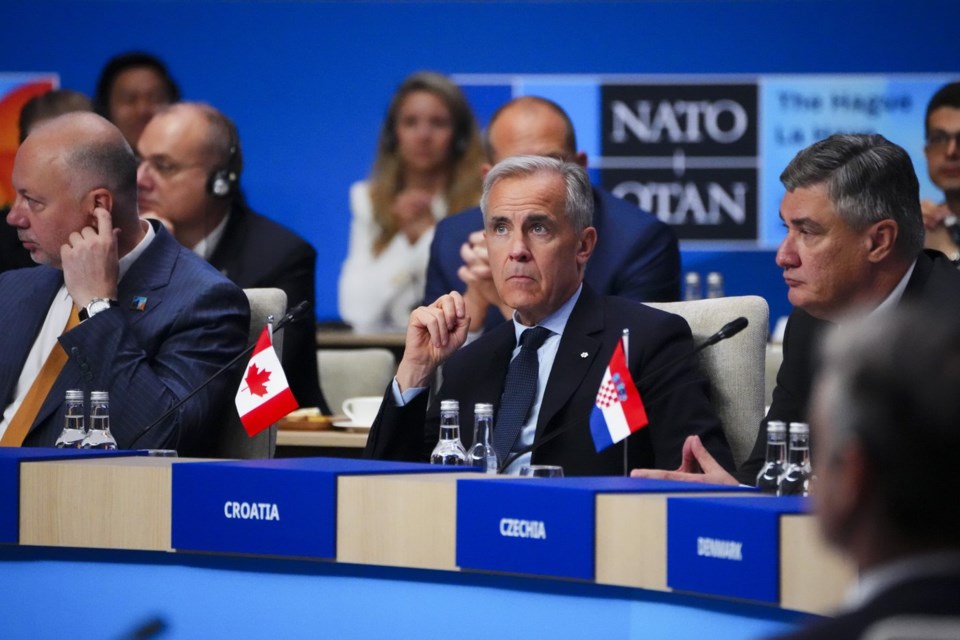THE HAGUE — Canada and its NATO allies agreed at their annual summit on Wednesday to substantially hike their defence spending target to five per cent of annual GDP by 2035, Prime Minister Mark Carney said.
Carney warned the country can no longer rely on its geography for protection as new weapons and threats emerge, and argued the deterrent value of the alliance will increase as members collectively embark on a massive defence buildup.
"The deterrence element of NATO has just gone up substantially and it's crucial — and we would really feel it if we went in the other direction," Carney said at a press conference on the sidelines of the NATO summit in The Hague.
NATO members agreed Wednesday to a plan put forward by NATO Secretary-General Mark Rutte that says they will invest 3.5 per cent of their national GDP in core defence needs — such as jets and other hardware — and another 1.5 per cent in related areas, such as infrastructure and cybersecurity.
The new five per cent target more than doubles the previous target of two per cent, which Canada struggled to meet for years. It comes in response to repeated demands by U.S. President Donald Trump, who has long accused allies of not paying their fair share.
Carney has said the new NATO agreement will see Canada's annual defence budget increase to roughly $150 billion.
NATO data shows Canada spent $41 billion on defence in 2024, about 1.4 per cent of its GDP. Earlier this month, Carney said Canada would hike defence spending to meet the two per cent target this year.
Carney said the higher level of defence spending will boost the economy and pointed out that the 1.5 per cent "industrial element" includes spending on critical mineral development, ports, airports and telecommunications — things Canada was already looking to build.
The pledge includes no requirement for incremental annual increases to member nations' defence budgets — leaving Canada with a decade to hit the mark.
Carney also said the new pledge will be reviewed in 2029 to "ensure that the commitments align with the global security landscape."
The next U.S. presidential election happens in 2028 and Trump is limited by the U.S. Constitution to just two terms in office — although he has mused about somehow trying to secure a third term.
The prime minister said Wednesday he was not ready to talk about budget cuts to offset new defence spending, arguing that issue won't emerge for years to come.
"Depending on how the threat environment evolves globally, if we are moving to the higher and higher levels of defence spending because that's necessary, then we will have to make considerations about what less the federal government can do in certain cases and how we're going to pay for it," he told reporters.
"Those trade-offs happen toward the end of the decade into the next decade, and … there's going to be a very clear and open conversation about that based on facts and based on what Canadians want."
Canada has not spent the equivalent of five per cent of GDP on defence since the 1950s and currently no member of NATO — not even the U.S. — meets that benchmark.
Desjardins warned in an analysis sent by email Wednesday that higher defence expenditures are going to increase federal spending "substantially." While Carney said five per cent of GDP would be $150 billion, Desjardins said it will be over $200 billion.
"However, our research found that the current NATO definition of what qualifies as a defence expenditure is very narrow, and current plans to categorize a wide range of federal government spending as military spending may be ambitious," the statement said.
The analysis also said that planned increases in defence expenditures are "likely to lead to significantly larger deficits, higher debt and increased issuance."
Before Wednesday's official NATO meeting on Wednesday, Carney held bilateral talks with Prime Minister Christopher Luxon of New Zealand and Prime Minister Kristen Michal of Estonia.
Carney was also seen chatting with several leaders in the room at Wednesday's meeting, including French President Emmanuel Macron and British Prime Minister Keir Starmer. Foreign Affairs Minister Anita Anand also went over to speak for a few minutes with U.S. Defence Secretary Pete Hegseth.
Rutte said the meeting comes at a dangerous time, citing wars in the Middle East and Ukraine.
"This decision is deeply rooted in our core mission and is required to resource our plans and readiness," Rutte said. "This will also make NATO fairer, to ensure anyone and everyone contributes their fair share for our security.
"For too long, one ally, the United States, carried too much of the burden of that commitment. And that changes today," he added, saying that Trump "made this change possible."
David Pierce, vice president of government relations at the Canadian Chamber of Commerce, was in The Hague for the summit and presented a statement to Rutte highlighting the ties between defence and industry.
Pierce said Wednesday the NATO announcement is "seeking to meet a historic moment." He said the conversation from now until 2035 will be about "getting the balance right."
"Industry is ready and eager to work on the 1.5 (per cent) of the spending that involves critical minerals, transportation infrastructure and other key investments, which will spur economic growth and benefit our long-term economic resilience," he said.
— With files from The Associated Press and Kyle Duggan in Ottawa
This report by The Canadian Press was first published June 25, 2025.
Catherine Morrison, The Canadian Press


